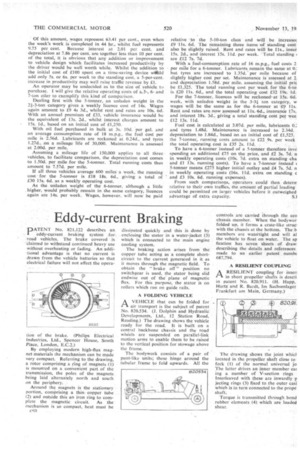Eddy-current Braking
Page 202

If you've noticed an error in this article please click here to report it so we can fix it.
pATENT No. 821,122 describes an eddy-current braking system for road vehicles. The brake covered is
• claimed to withstand continued heavy use without overheating or fading. An additional advantage is that no current is drawn from the vehicle batteries so that electrical failure will not affect the opera tion of the brake. (Philips Electrical Industries, Ltd., Spencer House, South Place, London, E.C.2.) By employing modern high-flux magnet materials the mechanism can be made very compact. Referring to the drawing, a rotor comprising a ring of magnets. (1) is mounted on a convenient part of the transmission, the poles of the magnets being laid alternately north and south on the periphery.
Around the magnets is the stationary portion, comprising a thin copper tube (2) and outside this an iron ring to complete the magnetic circuit. As the mechanism is so compact, heat must be c60 dissipated quickly and this is done by enclosing the stator in a water-jacket (3) which is connected to the main engine cooling system.
The braking action arises from the copper tube acting as a complete shortcircuit to the current generated in it as it moves through the magnetic field. To obtain the "brake off" position no switchgear is used, the stator being slid endwise out of the plane of magnetic flux. For this purpose, the stator is on rollers which run on guide rails.
A FOLDING VEHICLE
I-I A VEHICLE that can be folded for
air transport is the subject of patent No. 820,534. (1. Dolphin and Hydraulic Developments, Ltd., 12 Station Road, Reading.) The drawing shows the vehicle ready for the road. It is built on a central backbone chassis and the road wheels are suspended on parallel-link motion arms to enable them to be raised to the vertical position for stowage above the frame.
The bodywork consists of a pair of punt-like units; these hinge around the tubular frame to fold upwards. All the controls are carried through the cen chassis member. When the bodywor folded up, it forms a crate-like state' with the chassis at the bottom. The b members are watertight and will al the vehicle to float on water. The sp fication has seven sheets of draw; describing the details and references made to an earlier patent numb( 687,794.
A RESILIENT COUPLING
PAA RESILIENT coupling for inseri in short propeller shafts is descri in patent No. 820,911. (H. Happ, Hartz and R. Bardt, Im Sachsenlager Frankfurt am Main, Germany.)
The drawing shows the joint which located in the propeller shaft close to fork (I) of the normal universal jo The latter drives an inner member cat log a number of V-section rings Interleaved with these are inwardly p jecting rings (3) fixed to. the outer casi which is in turn connected to the prop& shaft.
Torque is transmitted through bond rubber elements (4) which are loaded shear.
































































































































































































































































